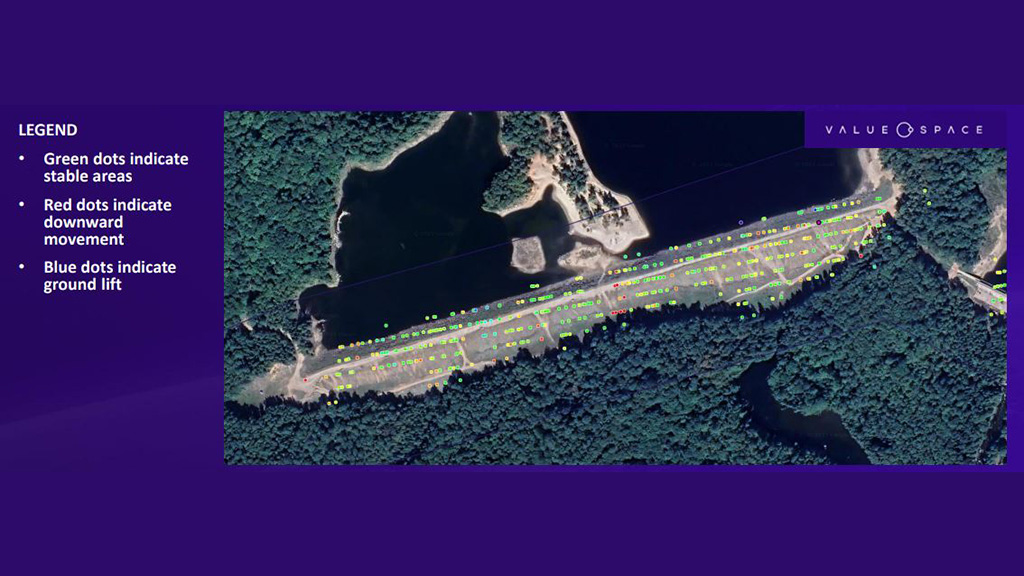The principals of U.K. insurtech company Value.Space admit they find it hard to stand idly by when there are potential disasters threatening major pieces of infrastructure around the world.
The firm has extensive experience in forensic analysis of past dam failures and proactive identification of infrastructure deformation, enabled mainly by retrieving historical and current satellite data. Value.Space has profiled 4,000 assets worth $25 billion in 70 countries for its insurance clients.
So in December when staff received an alert that hundreds of residents of the villages of Chute-Saint-Philippe and Lac-des-Ecorces in Quebec’s Laurentian Mountains were being evacuated due to concerns about the structural integrity of the 69-year-old Morier dike, they sprang into action, preparing a flash analysis of the dike.
“It’s an occupational hazard because we try to prevent things,” said Agu Leinfeld, a co-founder of Value.Space.
“We are constantly checking the news feeds, we’re constantly checking engineering channels.”
Value.Space analyzed the dike’s structural behaviour across 18 months prior to when the instability was discovered by Quebec’s Ministry of Environment, from May 10, 2022 to Nov. 13, 2023, which is around the time when the Ministry’s General Directorate of Dams detected an increase in water at the downstream foot of the Morier dike.
Value.Space uses visual assessments as well as multiple data sets from temperature monitoring, moisture, changes in shape, size and location, climate analysis and other inputs.
Its assessment of the Morier dike revealed seven significant movements, potentially indicating structural weaknesses that existed before or developed during the period of the analysis.
In one case, Finding 3, a structural movement stood out due to being different from the adjacent areas on the dike slope.
Additionally, while the data clusters on the top of the dike indicated lift, there was downward movement on the toe of the dike, Value.Space reported.
Movements in different directions across a dike section can indicate structural weakness. The data timeline showed the change of stability assessed in Finding 3 occurred from February 2023 onward. The movement velocity is up to 22.12 millimetres a year.
The report concluded the overall picture of the Morier dike is similar to past examples of dams that eventually failed.
“Sometimes we check, is there a correlation with the moisture for example, you don’t want to see pockets of moisture in the body of the dam constantly appearing, things like that,” said Leinfeld. “So there’s multiple readings.
“We also start by understanding the asset itself. We usually look up all the engineering materials that are available before we send something out.”
The residents of the two communities were evacuated Dec. 3 and permitted to return Dec. 14.
Frederic Fournier, director of communications for the Ministry of Environment, outlined the ministry’s emergency measures plan including the excavation of a trench 165 metres long downstream to help groundwater drainage along with piezometric and geophysical surveys to assess the threat of a breach.
As a precautionary measure, Fournier said, the annual lowering of the Kiamika reservoir has been accelerated by increasing the flows discharged at the Kiamika Dam in order to more quickly reach the levels required to carry out more in-depth investigations and consolidation work. The level of monitoring of the structure has also been increased.
Leinfeld said Value.Space had not been in touch with the ministry to offer its unsolicited analysis. But he noted the profile of the dike was similar to numerous post-war dams and other public infrastructure around the world.
Not only are they nearing the end of their life cycles, with degradation of materials, they are being increasingly threatened by changes in climate patterns such as drought and precipitation, creating a “perfect storm” of threats.
“The purpose of this company is actually to build the best alarm system for critical infrastructure,” said Leinfeld.
“Most of the critical infrastructure has been built after World War Two. So most of the materials that engineers used, after 50 years…things start to deteriorate much faster, need to be checked more often.”
A key source of data for Value.Space is the European Space Agency’s (ESA) Sentinel-1 program of satellites, which use radar to capture high-resolution snapshots of the Earth’s surface day or night, in various weather conditions.
For almost a decade the ESA has been collecting information on ground deformation, ice motion, growth of vegetation and much more, leaving it in the public domain. Value.Space supplements the ESA data with information from other sources including NASA.
“Because of the radar we have a continuous timeline,” said Leinfeld.
“We can go back in time, we can see how all the infrastructures have been behaving historically.”
Leinfeld said the firm’s scope of projects at this point lies in dams, tailings storage facilities for mines and some other properties, noting each sector has a different engineering profile that Value.Space needs to understand. But he does not preclude the firm venturing into other types of infrastructure.
“Everybody’s looking for information,” he said. “We’ve got valuable assets. We want to ensure they’re in good shape on a regular basis.”
Follow the author on Twitter @DonWall_DCN



Wondering what the potential breach peak flow expectations would be in the case of a spring freshet rupture, and downstream effects and duration.